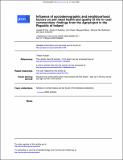Influence of sociodemographic and neighbourhood factors on self rated health and quality of life in rural communities: findings from the Agriproject in the Republic of Ireland

View/
Date
2004-01-26Author
Tay, Joseph
Kelleher, Cecily
Hope, Ann
Barry, Margaret M.
Nic Gabhainn, Saoirse
Sixsmith, Jane
Metadata
Show full item recordUsage
This item's downloads: 454 (view details)
Recommended Citation
Tay, J. B., Kelleher, C. C., Hope, A., Barry, M., Nic Gabhainn, S., & Sixsmith, J. (2004). Influence of sociodemographic and neighbourhood factors on self rated health and quality of life in rural communities: findings from the Agriproject in the Republic of Ireland. Journal of Epidemiology and Community Health, 58(11), 904-911.
Published Version
Abstract
Objective: To examine the influence of sociodemographic and neighbourhood factors on self rated health, quality of life, and perceived opportunities for change (as one measure of empowerment) in rural Irish communities.
Design: Pooled data from cross sectional surveys two years apart.
Setting: Respondents in four randomly selected rural district electoral divisions with a population size of between 750 and 2000.
Participants: 1738 rural dwellers aged 15-93, 40.5% men, interviewed at two time points.
Main outcome measures: Determinants of self rated health (SRH), quality of life (QOL), and perceived opportunities for change, rated on a closed option Likert scale and assessed in multivariate logistic regression models.
Main results: Overall 23.8% of the sample reported poor SRH, 22.2% poor QOL, and 50.1% low perceived opportunities for change. Low financial security and dissatisfaction with work were each significantly associated with poor SRH (OR = 1.96 (1.50 to 2.56) and 1.54 (1.11 to 2.14)), with poor QOL (OR = 2.04 (1.56 to 2.68) and 1.87 (1.34 to 2.61). Concern about access to public services was significantly predictive of SRH (OR = 1.47 (1.11 to 1.94)) rather than access to health care (that is, hospital and GP services). There were distinct sex specific patterns and a generational effect for educational status in men. Variables associated with social networks and social support were less strongly predictive of SRH and QOL when economic measures were accounted for.
Conclusion: Inter-relations between indicators of health status, wellbeing, and deprivation are not well studied in rural communities. Material deprivation has a direct influence on both health status and quality of life, although immediate sources of support are relatively well preserved.

